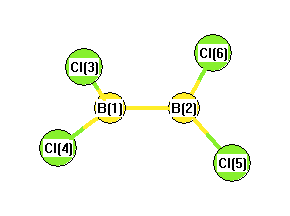Geometric Data

Point Group D2d
Internal coordinates
distances (r) in Å, angles (a) in degrees, dihedrals (d) in degrees
Cartesians
| Atom |
x (Å) |
y (Å) |
z (Å) |
| B1 |
0.0000 |
0.0000 |
0.8510 |
| B2 |
0.0000 |
0.0000 |
-0.8510 |
| Cl3 |
0.0000 |
1.5140 |
1.7286 |
| Cl4 |
0.0000 |
-1.5140 |
1.7286 |
| Cl5 |
1.5140 |
0.0000 |
-1.7286 |
| Cl6 |
-1.5140 |
0.0000 |
-1.7286 |
Atom - Atom Distances 
Distances in Å
| |
B1 |
B2 |
Cl3 |
Cl4 |
Cl5 |
Cl6 |
| B1 |
|
1.7020 | 1.7500 | 1.7500 | 2.9911 | 2.9911 |
| B2 |
1.7020 |
|
2.9911 | 2.9911 | 1.7500 | 1.7500 |
| Cl3 |
1.7500 | 2.9911 |
|
3.0280 | 4.0666 | 4.0666 |
| Cl4 |
1.7500 | 2.9911 | 3.0280 |
|
4.0666 | 4.0666 |
| Cl5 |
2.9911 | 1.7500 | 4.0666 | 4.0666 |
|
3.0280 |
| Cl6 |
2.9911 | 1.7500 | 4.0666 | 4.0666 | 3.0280 |
|
Calculated geometries
for B
2Cl
4 (Diboron tetrachloride).
Experimental Bond Angles (degrees) from cartesians 
| atom1 |
atom2 |
atom3 |
angle |
|
atom1 |
atom2 |
atom3 |
angle |
| B1 |
B2 |
Cl5 |
120.100 |
|
B1 |
B2 |
Cl6 |
120.100 |
| B2 |
B1 |
Cl3 |
120.100 |
|
B2 |
B1 |
Cl4 |
120.100 |
| Cl3 |
B1 |
Cl4 |
119.800 |
|
Cl5 |
B2 |
Cl6 |
119.800 |
Bond descriptions
Examples: C-C single bond, C=C, double bond, C#C triple bond, C:C aromatic bond
| Bond Type |
Count |
| B-B |
1 |
| B-Cl |
4 |
Connectivity
| Atom 1 |
Atom 2 |
| B1 |
B2 |
| B1 |
Cl3 |
| B1 |
Cl4 |
| B2 |
Cl5 |
| B2 |
Cl6 |











